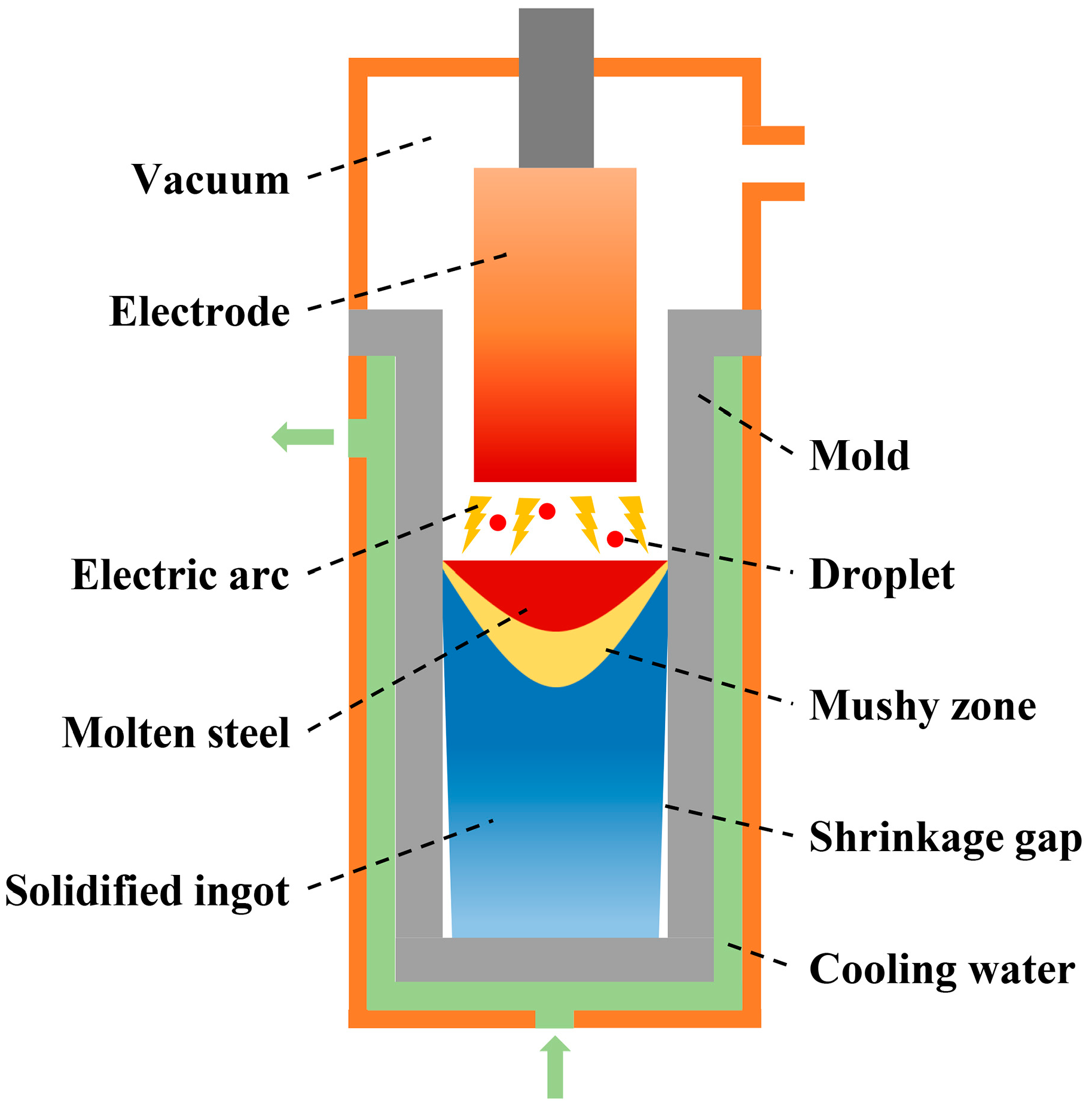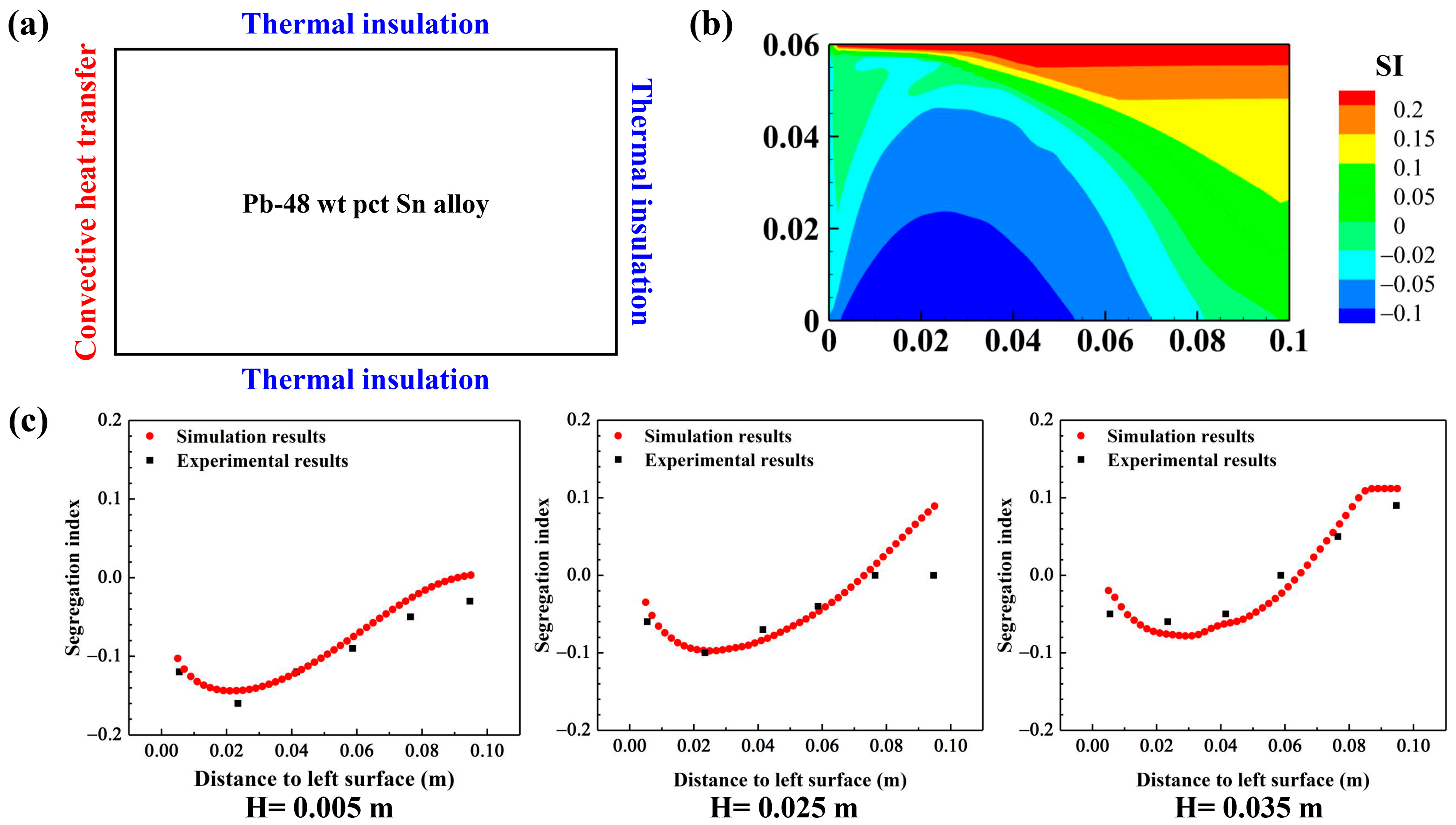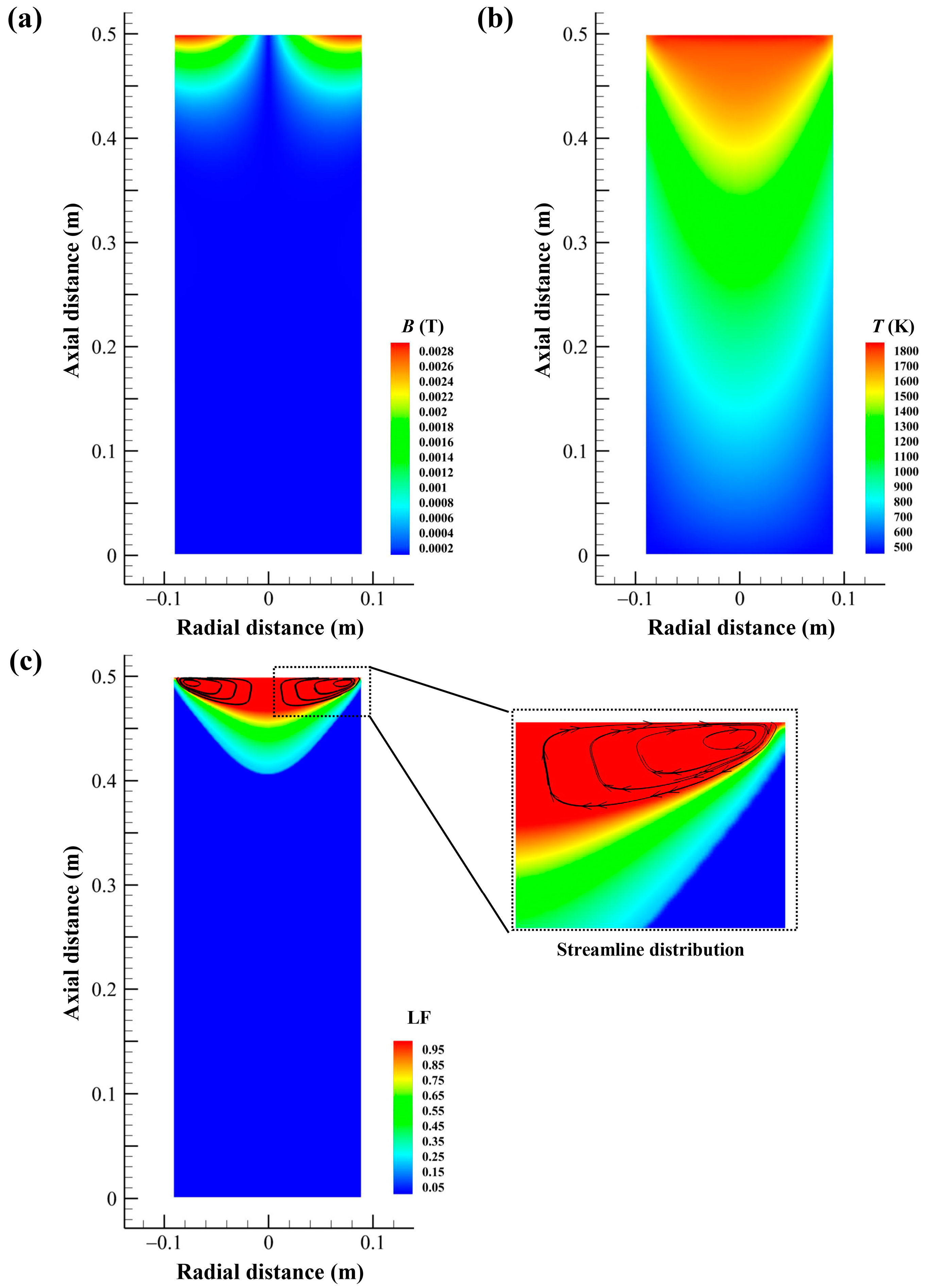Numerical Simulation of the Influence Mechanism of Melt Rate Variation on the Macrosegregation of 8Cr4Mo4V-Bearing Steel During Vacuum Arc Remelting
Abstract
1. Introduction
2. Numerical Model Description
2.1. General Assumptions
- This research focuses on the ingot, without considering the electrode, vacuum arc and mold [16].
- The ingot is assumed to be a completely symmetrical cylinder, and the numerical model is simplified to a 2D axisymmetric model.
2.2. Electromagnetic Field
2.3. Mass Transfer
2.4. Fluid Flow
2.5. Heat Transfer
2.6. Solute Transport
2.7. Influence of Metal Droplets
3. Benchmark Configuration and Numerical Procedures
3.1. Numerical Implementation
3.2. Boundary Conditions
3.3. Properties and Parameter Settings
4. Results and Discussion
4.1. Model Validation
4.2. Distribution of Physical Fields in Ingot
4.3. Macrosegregation of the Carbon Element in a 8Cr4Mo4V Ingot
4.4. Variation in Carbon Macrosegregation with Melt Rate
5. Conclusions
- Under the operating conditions of the VAR process described in this paper, thermal buoyancy dominates the flow in the molten pool, causing the molten steel to flow down along the solidification front. This leads to positive segregation in the center and negative segregation close to the ingot’s edge.
- Solute enrichment reduces the undercooling of the alloy system, thereby decreasing the local solidification rate, resulting in a slight increase in the depth of the steady-state molten pool. This increase in molten pool depth reduces the temperature gradient, which in turn accelerates the local solidification rate. Consequently, the positive segregation degree in the ingot center is gradually alleviated, and the molten pool depth gradually decreases.
- The molten pool depth increases with the increase in melt rate, resulting in a higher velocity of molten steel flow. The accelerated migration of solute elements to the center exacerbates positive segregation at the ingot’s center. The maximum positive segregation index at melt rates of 1.2, 1.3 and 1.4 kg/min are 0.07, 0.13 and 0.21, respectively.
- The more serious the solute enrichment, the greater the decrease in undercooling, resulting in a greater increase in the molten pool depth. With an increase in melt rate, both the fluctuation range of the steady-state molten pool depth and the positive segregation at the ingot’s center increase.
Author Contributions
Funding
Data Availability Statement
Conflicts of Interest
References
- Gruber, H. Consumable-electrode vacuum arc melting. JOM 1958, 10, 193. [Google Scholar] [CrossRef]
- Soler, M.F.; Niemeyer, K.E. Analysis of an Approach for Detecting Arc Positions During Vacuum Arc Remelting Based on Magnetic Flux Density Measurements. J. Manuf. Sci. Eng. 2018, 140, 071004. [Google Scholar] [CrossRef]
- Quatravaux, T.; Ryberon, S.; Hans, S.; Jardy, A.; Lusson, B.; Richy, P.E.; Ablitzer, D. Transient VAR ingot growth modelling: Application to specialty steels. J. Mater. Sci. 2004, 39, 7183. [Google Scholar] [CrossRef]
- Jardy, A.; Ablitzer, D. Mathematical modelling of superalloy remelting operations. Mater. Sci. Technol. 2013, 25, 163. [Google Scholar] [CrossRef]
- Yang, Z.J.; Kou, H.C.; Li, J.S.; Hu, R.; Chang, H.; Zhou, L. Macrosegregation Behavior of Ti-10V-2Fe-3Al Alloy During Vacuum Consumable Arc Remelting Process. J. Mater. Eng. Perform. 2011, 20, 65. [Google Scholar] [CrossRef]
- Han, J.J.; Ren, N.; Zhou, Y.; Zhang, R.Y.; Li, J.; Huang, X.; Li, J.F. Melt convection and macrosegregation in the vacuum arc remelted Ti2AlNb ingot: Numerical methods and experimental verification. J. Mater. Process Technol. 2022, 308, 117729. [Google Scholar] [CrossRef]
- Cui, J.J.; Li, B.K.; Liu, Z.Q.; Qi, F.S.; Zhang, X.P. Numerical investigation on the effect of axial magnetic field on metallurgical quality of ingots during vacuum arc remelting process. J. Mater. Res. Technol. 2022, 20, 1912. [Google Scholar] [CrossRef]
- Delzant, P.; Chapelle, P.; Jardy, A.; Matveichev, A.; Millet, Y. Impact of a transient and asymmetrical distribution of the electric arc on the solidification conditions of the ingot in the VAR process. Metals 2022, 12, 500. [Google Scholar] [CrossRef]
- Cui, J.J.; Li, B.K.; Liu, Z.Q.; Qi, F.S.; Xu, J.X.; Zhang, J. Comparative investigation on ingot evolution and product quality under different arc distributions during vacuum arc remelting process. J. Mater. Res. Technol. 2022, 18, 3991. [Google Scholar] [CrossRef]
- Zagrebelnyy, D.; Krane, M.J.M. Segregation development in multiple melt vacuum arc remelting. Metall. Mater. Trans. B 2009, 40, 281. [Google Scholar] [CrossRef]
- Guan, J.; Miao, Y.Y.; Chen, Z.Z.; Liu, D.R.; Cao, Y.F.; Li, D.Z. Modeling of macrosegregation formation and the effect of enhanced cooling during vacuum arc remelting solidification of NbTi alloy ingot. Metall. Mater. Trans. B 2022, 53, 4048. [Google Scholar] [CrossRef]
- Jiang, D.B.; Yang, F.Z.; Zhang, J.; Zhou, Y.; Zhang, L.F. Effect of feeding parameters on ingot segregation and shrinkage pore in vacuum arc remelting. J. Iron Steel Res. Int. 2022, 30, 1268. [Google Scholar] [CrossRef]
- Williamson, R.L.; Beaman, J.J.; Melgaard, D.K.; Shelmidine, G.J.; Morrison, R. Model-based melt rate control during vacuum arc remelting of alloy 718. Metall. Mater. Trans. B 2004, 35, 101. [Google Scholar] [CrossRef]
- Williamson, R.L.; Beaman, J.J. Modern control theory applied to remelting of superalloys. Mater. Sci. Forum 2012, 706–709, 2484. [Google Scholar] [CrossRef]
- Mitchell, A. Electrode manufacture for the remelting processes. Ironmak. Steelmak. 2020, 48, 505. [Google Scholar] [CrossRef]
- Gartling, D.K.; Sackinger, P.A. Finite element simulation of vacuum arc remelting. Int. J. Numer. Methods Fluids 1997, 24, 1271. [Google Scholar] [CrossRef]
- Zhu, H.C.; Li, H.B.; Zhang, S.C.; Li, K.B.; Liu, G.H.; Jiang, Z.H.; Geng, X.; Han, P.D. Numerical simulation of Mo macrosegregation during ingot casting of high-Mo austenitic stainless steel. Ironmak. Steelmak. 2015, 42, 748. [Google Scholar] [CrossRef]
- Kihara, K.; Okada, N.; Saito, S.; Kawashima, K. Numerical simulation of macrosegregation in a continuous casting mold with electromagnetic stirring. ISIJ Int. 2022, 62, 1862. [Google Scholar] [CrossRef]
- Wu, M.; Zheng, Y.; Kharicha, A.; Ludwig, A. Numerical analysis of macrosegregation in vertically solidified Pb-Sn test castings–Part I: Columnar solidification. Comput. Mater. Sci. 2016, 124, 444. [Google Scholar] [CrossRef]
- Mramor, K.; Quatravaux, T.; Combeau, H.; Jardy, A.; Zalonik, M.; Crassous, I.; Gaillac, A. On the Prediction of Macrosegregation in Vacuum Arc Remelted Ingots. Metall. Mater. Trans. B 2022, 53, 2953. [Google Scholar] [CrossRef]
- Guan, J.; Liu, D.R.; Cao, Y.F.; Liu, H.W.; Fu, P.X.; Liu, H.H.; Sun, C.; Miao, Y.Y.; Li, D.Z. Macro and Micro Segregations and Prediction of Carbide Equivalent Size in Vacuum Arc Remelting of M50 Steel via Simulations and Experiments. Metall. Mater. Trans. A 2024, 55, 1081. [Google Scholar] [CrossRef]
- Li, T.; Shen, H.F. Multicomponent modeling of freckle formation in IN718 superalloy during horizontal directional solidification and vacuum arc remelting. Rare Metal. Mater. Eng. 2022, 51, 4076. [Google Scholar]
- Ren, N.; Li, J.; Panwisawas, C.; Xia, M.X.; Dong, H.B.; Li, J.G. Thermal-solutal-fluid flow of channel segregation during directional solidification of single-crystal nickel-based superalloys. Acta Mater. 2021, 206, 116620. [Google Scholar] [CrossRef]
- Li, J.; Wu, M.; Hao, J.; Ludwig, A. Simulation of channel segregation using a two-phase columnar solidification model—Part I: Model description and verification. Comput. Mater. Sci. 2012, 55, 407. [Google Scholar] [CrossRef]
- Ni, J.; Beckermann, C. A volume-averaged two-phase model for transport phenomena during solidification. Metall. Mater. Trans. B 1991, 22, 349. [Google Scholar] [CrossRef]
- Yang, L.W.; Ren, N.; Li, J.; Panwisawas, C.; Zhang, Y.C.; Xia, M.X.; Dong, H.B.; Li, J.G. Thermal-solutal convection-induced low-angle grain boundaries in single-crystal nickel-based superalloy solidification. J. Mater. Sci. Technol. 2024, 208, 214. [Google Scholar] [CrossRef]
- Ahmad, N.; Combeau, H.; Desbiolles, J.-L.; Jalanti, T.; Lesoult, G.; Rappaz, J.; Rappaz, M.; Stomp, C. Numerical simulation of macrosegregation: A comparison between finite volume method and finite element method predictions and a confrontation with experiments. Metall. Mater. Trans. A 1998, 29, 617. [Google Scholar] [CrossRef]
- Kumar, A.; Dussoubs, B.; Zaloznik, M.; Combeau, H. Effect of discretization of permeability term and mesh size on macro- and meso-segregation predictions. J. Phys. D Appl. Phys. 2009, 42, 105503. [Google Scholar] [CrossRef]
- Wu, M.; Domitner, J.; Ludwig, A. Using a Two-Phase Columnar Solidification Model to Study the Principle of Mechanical Soft Reduction in Slab Casting. Metall. Mater. Trans. A 2012, 43, 945. [Google Scholar] [CrossRef]
- Zhang, H.J.; Liu, X.S.; Ma, D.X.; Song, M.; Ludwig, A.; Kharicha, A.; Wu, M.H. Digital twin for directional solidification of a single-crystal turbine blade. Acta Mater. 2023, 244, 118579. [Google Scholar] [CrossRef]
- Jiang, D.B.; Zhu, M.Y.; Zhang, L.F. Roll-Gap deviation on centerline segregation evolution in continuous casting slab. Steel Res. Int. 2023, 94, 2200708. [Google Scholar] [CrossRef]
- Xu, X.W.; Ren, N.; Lu, Z.Q.; Mirihanage, W.; Tsang, E.; Leung, A.P.; Li, J.; Xia, M.X.; Dong, H.B.; Li, J.G. A Data-Driven approach for the fast prediction of macrosegregation. Metall. Mater. Trans. A 2024, 55, 2083. [Google Scholar] [CrossRef]
- Xu, X.; Zhang, W.; Lee, P.D. Tree-ring formation during vacuum arc remelting of INCONEL 718: Part II. Mathematical modeling. Metall. Mater. Trans. A 2002, 33, 1805. [Google Scholar] [CrossRef]
- Spitans, S.; Franz, H.; Scholz, H.; Reiter, G.; Baake, E. Numerical simulation of the ingot growth during the vacuum arc remelting process. Magnetohydrodynamics 2017, 53, 557. [Google Scholar]
- Karimi-Sibaki, E.; Kharicha, A.; Wu, M.H.; Ludwig, A.; Bohacek, J. A parametric study of the vacuum arc remelting (VAR) process: Effects of arc radius, side arcing, and gas cooling. Metall. Mater. Trans. B 2020, 51, 222. [Google Scholar] [CrossRef]
- Kondrashov, E.N.; Musatov, M.I.; Maksimov, A.Y.; Goncharov, A.E.; Konovalov, L.V. Calculation of the molten pool depth in vacuum arc remelting of alloy Vt3-1. J. Eng. Thermophys. 2007, 16, 19. [Google Scholar] [CrossRef]
- Yang, Z.J.; Zhao, X.H.; Kou, H.C.; Li, J.S.; Hu, R.; Zhou, L. Numerical simulation of temperature distribution and heat transfer during solidification of titanium alloy ingots in vacuum arc remelting process. Trans. Nonferrous Met. Soc. China 2010, 20, 1957. [Google Scholar] [CrossRef]
- Kou, H.C.; Zhang, Y.J.; Li, P.F.; Zhong, H.; Hu, R.; Li, J.S.; Zhou, L. Numerical Simulation of Titanium Alloy Ingot Solidification Structure during VAR Process Based on Three-Dimensional CAFE Method. Rare Met. Mater. Eng. 2014, 43, 1537. [Google Scholar] [CrossRef]
- Williamson, R.L.; Shelmidine, G.J. Current paths during vacuum arc remelting of alloy 718. In Proceedings of the 5th International Symposium on Superalloys 718, 625, 706 and Various Derivatives, Pittsburgh, PA, USA, 17–20 June 2001; p. 91. [Google Scholar]
- Pericleous, K.; Djambazov, G.; Ward, M.; Yuan, L.; Lee, P.D. A Multiscale 3D Model of the Vacuum Arc Remelting Process. Metall. Mater. Trans. A 2013, 44, 5365. [Google Scholar] [CrossRef]
- Chapelle, P.; Ward, R.M.; Jardy, A.; Weber, V.; Bellot, J.P.; Minvielle, M. Lateral boundary conditions for heat transfer and electrical current flow during vacuum arc remelting of a zirconium alloy. Metall. Mater. Trans. B 2009, 40, 254. [Google Scholar] [CrossRef]
- Guo, J.; Huang, L.Q.; Wu, J.Y.; Li, J.J.; Wang, J.C.; Fan, K. Evolution of macrosegregation during three-stage vacuum arc remelting of titanium alloys. Acta Metall. Sin. 2024, 60, 1531. [Google Scholar]
- Hebditch, D.J.; Hunt, J.D. Observations of ingot macrosegregation on model systems. Metall. Trans. 1974, 5, 1557. [Google Scholar] [CrossRef]
- Lee, J.; Lee, K.; Mok, J. The effects of thermosolutal convection on macrosegregation during alloy solidification. ISIJ Int. 2005, 45, 1151. [Google Scholar] [CrossRef][Green Version]
- Guillemot, G.; Gandin, C.-A.; Combeau, H. Modeling of macrosegregation and solidification grain structures with a coupled cellular automaton-finite element model. ISIJ Int. 2006, 46, 880. [Google Scholar] [CrossRef]
- Tu, W.T.; Shen, H.F.; Liu, B.C. Numerical simulation of macrosegregation during solidification of binary alloys. Rare Met. 2016, 35, 591. [Google Scholar] [CrossRef]
- He, Z.Y.; Zhu, H.C.; Li, H.B.; Ni, Z.W.; Luo, H.X.; Feng, H.; Zhang, S.C.; Jiang, Z.H. Carbon macrosegregation pattern in 30Cr15Mo1N ingot: Impact of pouring rate. Steel Res. Int. 2024, 95, 2300908. [Google Scholar] [CrossRef]
- Pan, T.; Zhu, H.C.; Jiang, Z.H.; Li, H.B.; Zhang, R.; Feng, H. Mechanism of local solidification time variations with melt rate during vacuum arc remelting process of 8Cr4Mo4V high-strength steel. J. Iron Steel Res. Int. 2024, 31, 377. [Google Scholar] [CrossRef]
- Davidson, P.A.; He, X.; Lowe, A.J. Flow transitions in vacuum arc remelting. Mater. Sci. Technol. 2000, 16, 699. [Google Scholar] [CrossRef]
- Wang, X.H.; Ward, R.M.; Jacobs, M.H.; Barratt, M.D. Effect of variation in process parameters on the formation of freckle in INCONEL 718 by vacuum arc remelting. Metall. Mater. Trans. A 2008, 39, 2981. [Google Scholar] [CrossRef]
















| Process Parameters | |
|---|---|
| Height of final ingot | 500 mm |
| Diameter of ingot | 180 mm |
| Diameter of electrode | 130 mm |
| Current | 2.4 kA |
| Melt rate | 1.2 kg·min−1 |
| 8Cr4Mo4V | |
|---|---|
| Density | 7419 kg·m−3 |
| Viscosity | 0.006 Pa·s |
| Specific heat | 663 J·kg−1·K−1 |
| Thermal conductivity | 32 W·m−1·K−1 |
| Slope of the liquidus | −9211 K |
| Partitioning coefficient of the C element | 0.31 |
| Solute diffusion coefficient in the liquid phase | 2 × 10−8 m2·s−1 |
| Solute diffusion coefficient in the solid phase | 1 × 10−9 m2·s−1 |
| Latent heat | 213,739 J·kg−1 |
| Thermal expansion coefficient | 0.000273 K−1 |
| Solutal expansion coefficient of the C element | 1.1 |
| Primary dendrite arm spacing | 350 μm |
| Secondary dendrite arm spacing | 100 μm |
Disclaimer/Publisher’s Note: The statements, opinions and data contained in all publications are solely those of the individual author(s) and contributor(s) and not of MDPI and/or the editor(s). MDPI and/or the editor(s) disclaim responsibility for any injury to people or property resulting from any ideas, methods, instructions or products referred to in the content. |
© 2025 by the authors. Licensee MDPI, Basel, Switzerland. This article is an open access article distributed under the terms and conditions of the Creative Commons Attribution (CC BY) license (https://creativecommons.org/licenses/by/4.0/).
Share and Cite
Pan, T.; Zhu, H.; Jiang, Z.; Li, H.; He, Z.; Ni, Z.; Liu, F.; Feng, H.; Zhang, S. Numerical Simulation of the Influence Mechanism of Melt Rate Variation on the Macrosegregation of 8Cr4Mo4V-Bearing Steel During Vacuum Arc Remelting. Metals 2025, 15, 76. https://doi.org/10.3390/met15010076
Pan T, Zhu H, Jiang Z, Li H, He Z, Ni Z, Liu F, Feng H, Zhang S. Numerical Simulation of the Influence Mechanism of Melt Rate Variation on the Macrosegregation of 8Cr4Mo4V-Bearing Steel During Vacuum Arc Remelting. Metals. 2025; 15(1):76. https://doi.org/10.3390/met15010076
Chicago/Turabian StylePan, Tao, Hongchun Zhu, Zhouhua Jiang, Huabing Li, Zhiyu He, Zhuowen Ni, Fubin Liu, Hao Feng, and Shucai Zhang. 2025. "Numerical Simulation of the Influence Mechanism of Melt Rate Variation on the Macrosegregation of 8Cr4Mo4V-Bearing Steel During Vacuum Arc Remelting" Metals 15, no. 1: 76. https://doi.org/10.3390/met15010076
APA StylePan, T., Zhu, H., Jiang, Z., Li, H., He, Z., Ni, Z., Liu, F., Feng, H., & Zhang, S. (2025). Numerical Simulation of the Influence Mechanism of Melt Rate Variation on the Macrosegregation of 8Cr4Mo4V-Bearing Steel During Vacuum Arc Remelting. Metals, 15(1), 76. https://doi.org/10.3390/met15010076








